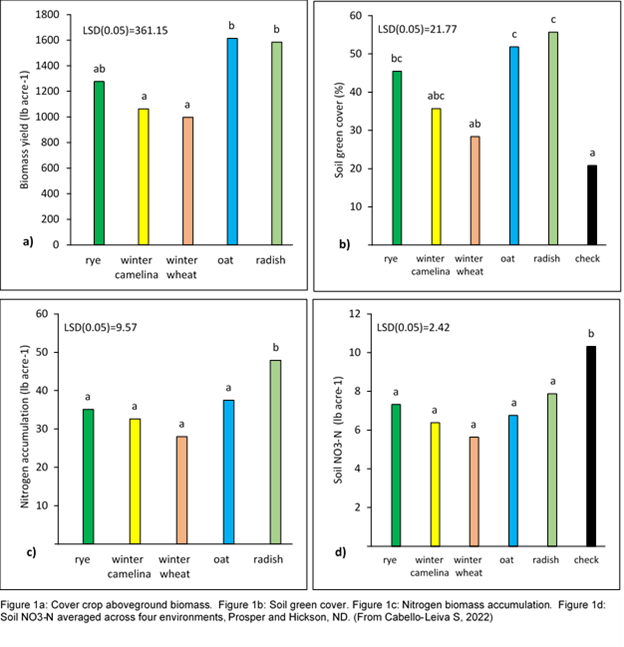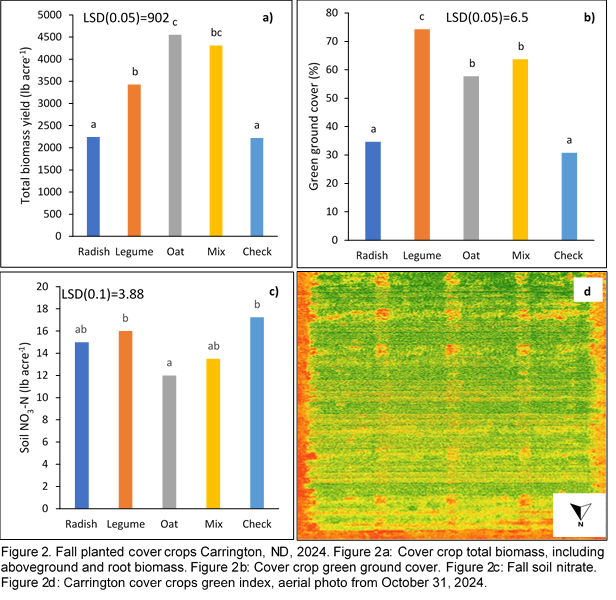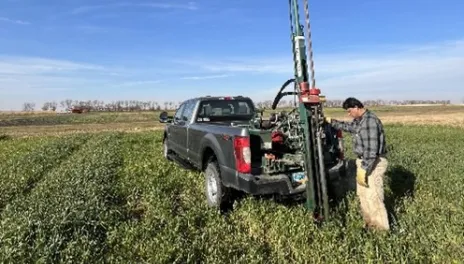Significant reduction of available soil nitrate through fall-planted cereal and brassica cover crops in North Dakota
Cover crops (CC) are temporary covers that provide soil protection when cash crops are prevented from being planted, seeded but not well established, or following harvest. Cover crop benefits include decreased soil erosion and improved soil aggregation, enhanced water infiltration, better root growth, added rhizosphere diversity, reduced nitrate leaching and/or denitrification depending on the weather, and decreased soil compaction depending on clay type and cover crop species.
Soil nitrate (NO3-N) leaching and denitrification in some soils are major sources of N loss in agricultural activities, estimated to be more than 19% of the total fertilizer N applied to crops globally. Cover crops can take up soil residual NO3-N, preventing its loss and leaving N in the cropping system. This N has the potential to be used by cash crops, decreasing fertilizer dependency in the medium and long term.
Research was conducted at the NDSU Prosper Research Farm and a farmer's field near Hickson, ND, under dryland transitional no-till conditions, in a wheat-cc-sugarbeet rotation, replicated over two years, resulting in four different environments. Spring wheat was seeded in late April each year, and the crop was fertilized based on soil analysis and ND wheat nutritional recommendations.
Cover crops were seeded into wheat stubble without tillage following spring wheat harvest in early August. Cover crop treatments were winter rye, winter camelina, winter wheat, oat, radish, legume mix (lupin+lentil), mix (lupin+lentil+oats), and a check without a cover crop (wheat regrowth).

Cover crop above-ground biomass samples were collected before the first frost of the fall by cutting the plants directly above the soil surface and total N accumulation was determined. Cover crop soil green coverage was obtained in late fall (before the first frost) using Canopeo © imagery through a cell phone app (Canopeo™, Oklahoma State University, Stillwater, OK), and it was expressed as a percentage of the total surface area.
In late fall, soil samples were collected, with three cores per experimental unit from the 0-6 inch and 6-24 inch depths. The soil samples were then dried and analyzed for NO3-N.
Figure 1a shows that cover crop biomass was greater in oats (1614 pounds per acre) and radish (1585 pounds per acre) than in winter camelina and winter wheat. However, when winter camelina and winter wheat are fall-seeded, it is expected that they will provide growth the following spring, adding more biomass to the system in the spring. Soil green cover surface area (Figure 1b) was significantly greater in oat (52%), radish (56%), and winter rye (45%), providing an excellent physical barrier against soil wind erosion.
Nitrogen accumulation in the biomass (Figure 1c) was greater in forage radish (48 pounds per acre). Soil residual NO3-N (6-24 inches) was less under all cover crops, with 24-46% less soil NO3-N (Figure 1d) than in the check treatment, indicating that the use of cover crops were actively scavenging soil NO3-N, reducing the system risk of N loss.

In Carrington 2024, cover crops show promising potential to enhance soil health. Figure 2a demonstrates that oat and cover crop mix can reach over 4000 lb per acre (above-ground biomass + root biomass). The green ground cover (Figure 2b) was significantly higher in oats, mix, and legume, a key factor in the Northern Great Plains, indicating a potentially drastic reduction in soil erosion risk. Figure 2d shows the green index cover in an aerial photo in late October 2024, presenting the effectiveness of cover crops in protecting soil in late fall. Soil available nitrate (Figure 2c) was 35% lower in oat plots than in the control, significantly reducing nitrogen leaching risk. This means that the nitrate is retained in the cover crops' biomass, making it available for future cash crops, thereby enhancing the long-term sustainability of farming practices and the health of our soils.

The biomass and soil green cover surface area from fall cover crops were greater in radish and oats than in the winter-hardy cover crops. Forage radish demonstrated the highest nitrogen (N) accumulation among all the treatments. We should consider CC legume results from Carrington, which will be available during this season, and which most likely will result in even higher N accumulation into biomass.
In late fall, the soil nitrate nitrogen (NO3-N) concentration in the top 24 inches was lower under almost all cover crops compared to the control treatment. These results suggest that cover crops actively scavenged NO3-N from the soil profile, helping protect the residual nitrogen from potential losses. This nitrogen will likely be cycled back into the soil system, where it will be released through physical and biological processes to benefit future crops.
This study highlights several benefits of fall-planted cover crops, including maintaining green cover late into the fall, reducing erosion risk, decreasing soil susceptibility to leaching, accumulating significant amounts of biomass and nitrogen, and providing habitat for microbiome and fauna in general. Ultimately, this nitrogen is expected to cycle back into the soil, becoming available for subsequent crops.
Please contact me if you have any questions or want to discuss the benefits and challenges of cover crops in North Dakota.
Acknowledgments: I thank Dr. Marisol Berti, Szilvia Yuja, and Naeem Kalwar for their invaluable collaboration on this project. This project was funded by USDA-NIFA under the Coordinated Agricultural Program, Award No. 2016-69004-24784, titled "CropSys - A Novel Management Approach to Increase Productivity, Resilience, and Long-Term Sustainability of Cropping Systems in the Northern Great Plains." Additionally, I sincerely thank ANID (Agencia Nacional de Investigación y Desarrollo, Chile) for their financial support, scholarship folio: 72180579, and the North Dakota Corn Utilization Council for their funding assistance.
Sergio Cabello Leiva, Ph. D.
sergio.cabelloleiva@ndsu.edu
Soil Scientist
